Sporting
Horse Power: The Annual Sale at Keeneland
For twelve days each September, racing’s elite arrive in Lexington to bid on yearling Thoroughbreds
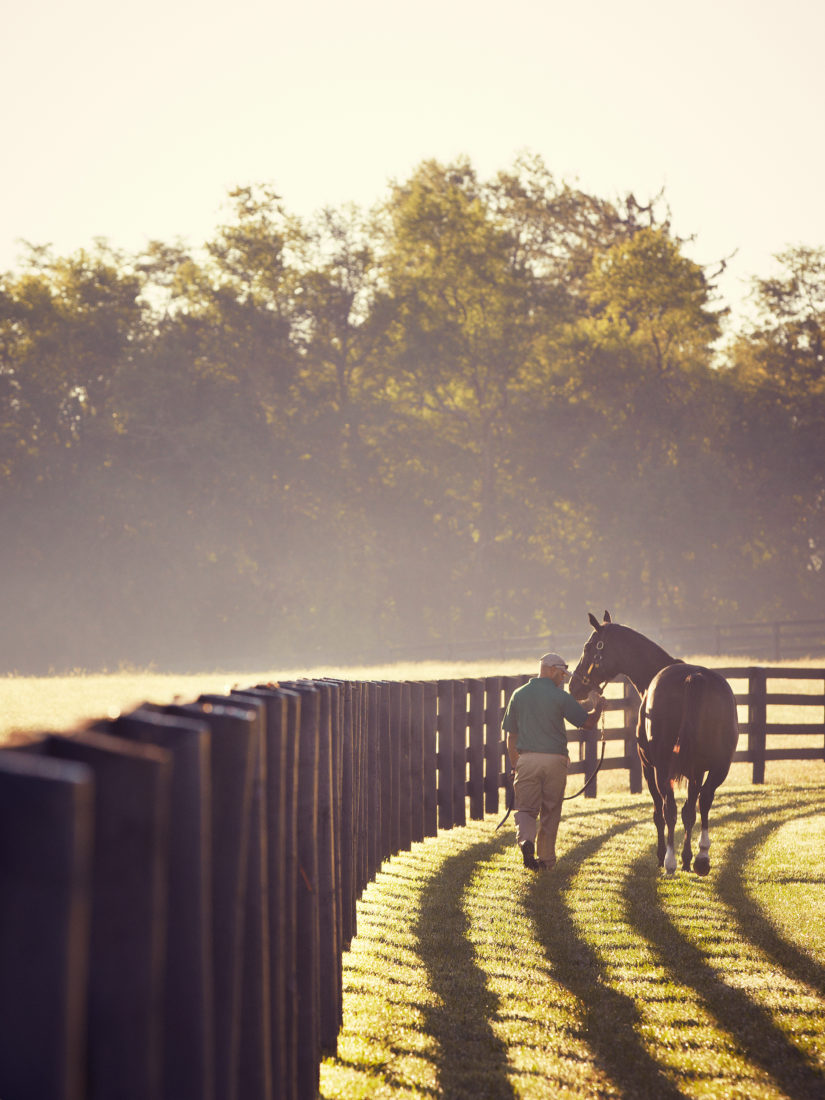
Photo: Joe Pugliese
“Have you seen the best horses? Well? Have you?” says the irrepressible George Bolton, as he hauls Ben Haggin and me up short on the finely groomed gravel between a couple of barns behind Keene-land’s sales pavilion. “I’m talking about the horses that would surprise me if they didn’t go big. Three or four of them. Because I can show them to you now.”
Haggin and I demur, chuckling at all this casual bravado, and stand around sort of scuffing at the gravel with our boots. To understand the bold impropriety of Bolton’s greeting, we have to take a step back and parse the ordinarily silent combat done in the run-up to a big horse auction. Keeneland’s September Thoroughbred yearling sale is beginning in three short hours, so the three dozen barns nearest the sales pavilion are roiling with hundreds of people—buyers, sellers, trainers, agents, and, not least, uniformed grooms coaxing today’s 132 superskittish, extremely shiny colts and fillies in and out of their stalls for go-sees. Irish, Russian, Japanese, and United Arab Emirates syndicates are full on the prowl. Sheikh Hamdan of Abu Dhabi’s 747, parked across the street at the airport, dwarfs the Lexington terminal itself. All of the horses—and, despite their professional exoskeletons of calm, most of the people—are freaking out.
Haggin, a principal of Woodford Racing, a prominent Lexington syndicate, is here to buy. Bolton, a San Francisco–based financier and stable owner, is too. Haggin’s polished Kentucky discretion adheres to Keeneland’s code, which is a cross between a Southerner’s understated, laconic air and full-on British military omertà, operational silence. In a paddock on sales days, everybody studying the horses being paraded before them speaks sotto voce in clipped, epigrammatic sentences, which—even if picked up by an FBI long-distance directional microphone—would still be impenetrably encoded interchanges between that buyer and his or her team of vets, trainers, and partners. Some buyers don’t utter declarative sentences in a paddock at all, preferring to make notes and ask a few questions, letting the consignors and sellers do the talking. The unstated rule is, miscreants and opponents abound, so talking demonstratively at volume about a horse in a paddock is like telling a man what’s in your hand before the ante at five-card stud.
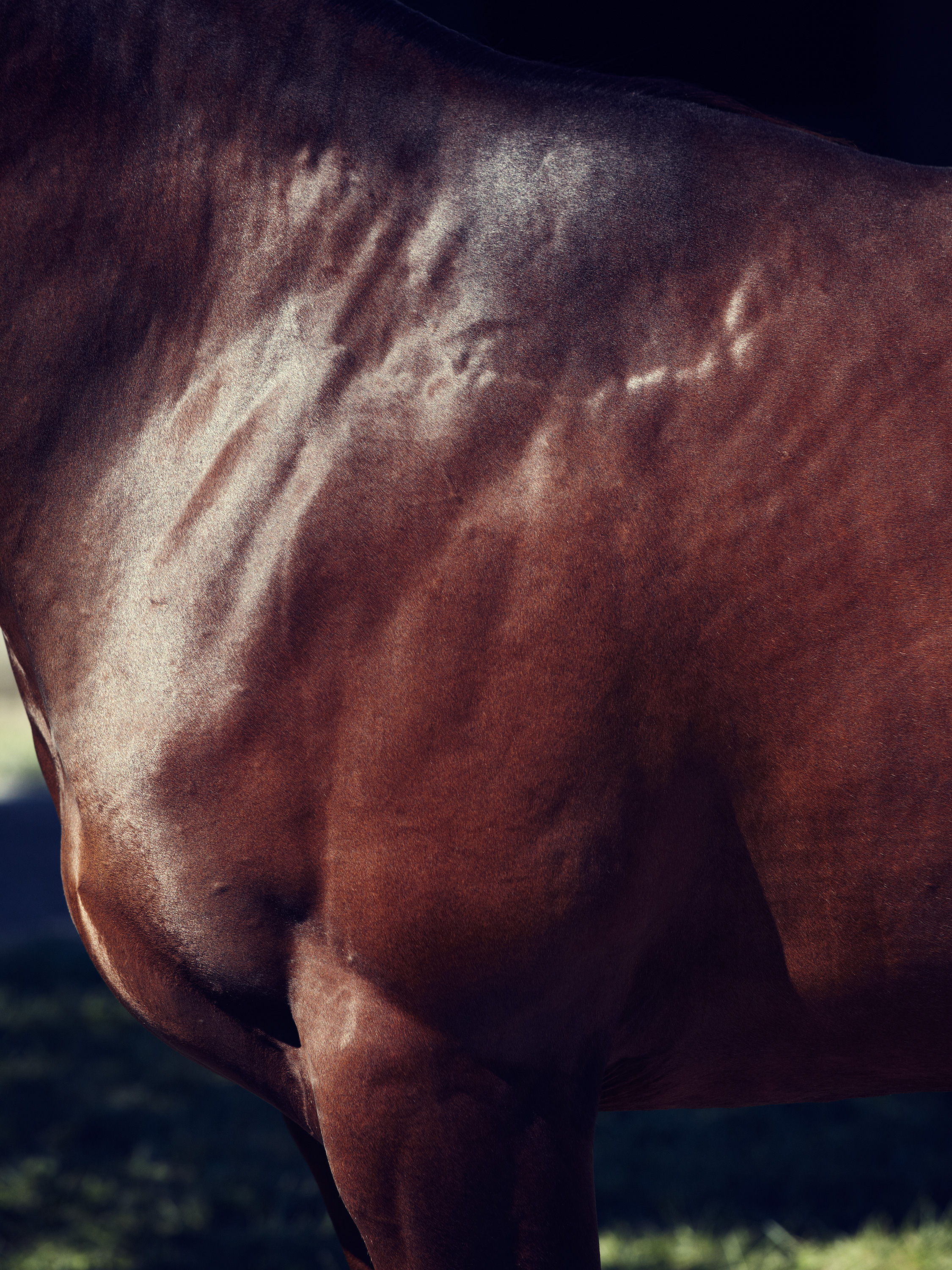
Photo: Joe Pugliese
The shoulder of a mature stallion.
However. As any executive or regular patron of Keeneland’s fall sales can also tell you, the beloved iconoclast George Bolton takes transparency to the max. The Bolton theory of pre-sales analysis runs something like this: All this not-talking about horses sticks in my craw, so let’s talk about some horses, shall we; here’s what I think, real loud, and yes, by the way, in case you were wondering, in an hour I’m buying that horse.
We’ve seen a lot of pretty horses this morning, I say to Bolton, which is paddock code for, we can’t know anything about the best; nothing’s under the hammer yet.
For Bolton, who is forty-nine—a former part owner of Curlin, the 2007 Preakness winner and two-time Horse of the Year now standing to stud at $40,000 a pop on Lane’s End Farm just outside Lexington—my ham-handed attempt at diplomacy is just so much weak tea. It’s clear that we haven’t seen the best.
“Well, come on,” he says breezily, “let’s go pull some horses out.”
Despite his hilariously casual smashing of paddock rigueur, Bolton is the kind of buyer Keeneland loves to see: one with a fifteen- to twenty-head stable running at the nation’s best tracks-—Santa Anita, Belmont, and Saratoga. Not least, he has reams of razor-sharp, well-researched horsemanship in his head and in the piles of notes he carries as he darts from stable to stable. He’s attired in black sneakers, no socks, khaki shorts, and regulation white polo shirt under a ragingly bright purple V-neck—he looks like he’s just polished off a tennis rival in straight sets and is about to be brought a perfectly chilled glass of white wine by the pool. Keeneland has neither tennis court nor pool, but Bolton has the brio to make you think that a pool with its own bartender is somehow never far from wherever he’s standing. Which is to say, he’s an anomaly at Keeneland in another way: He has none of the dusty, shit-kicking, horse-worn look that horsemen everywhere have, no matter what their station—not even in these last urgent hours before the sales begin.
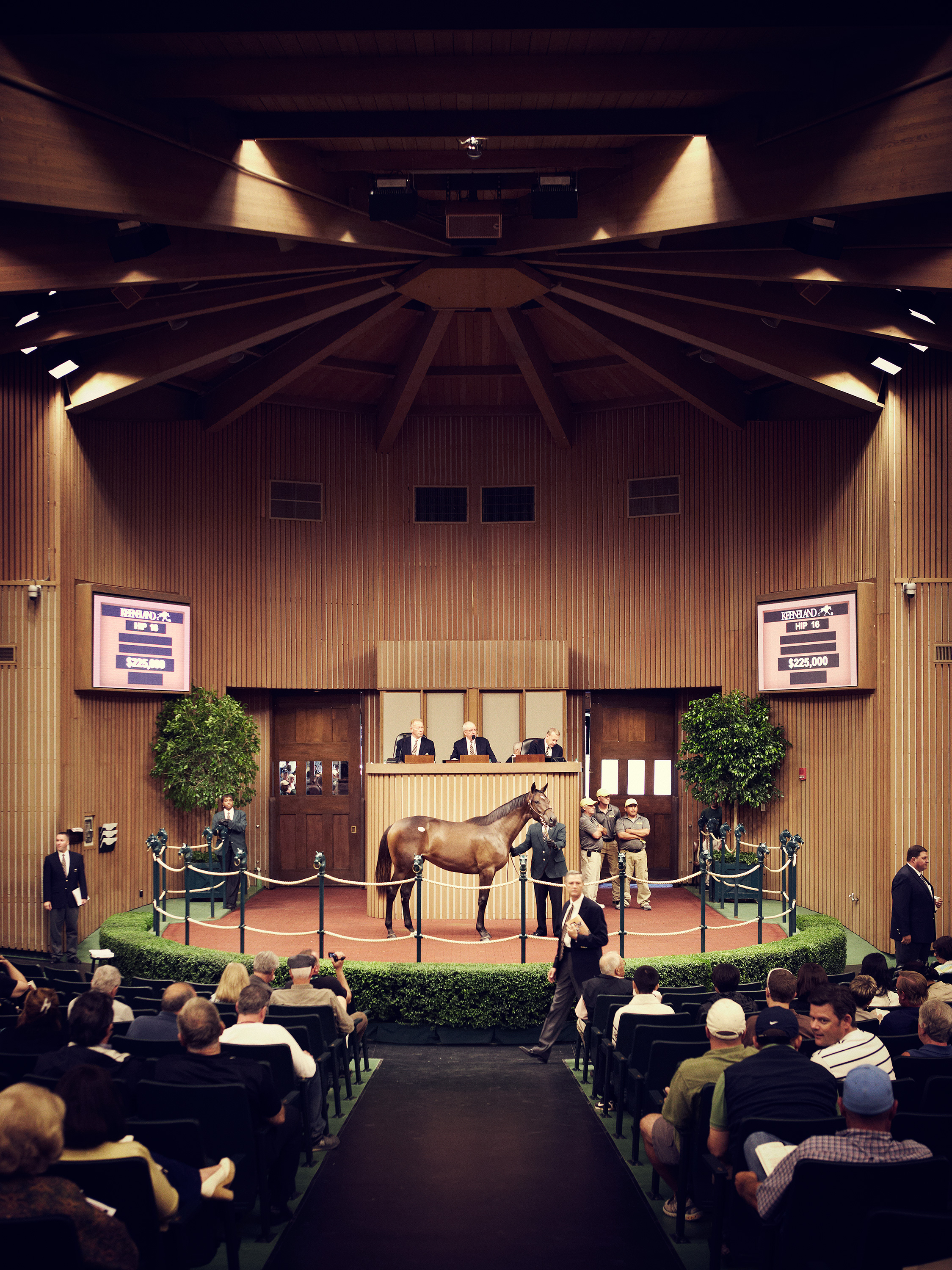
Photo: Joe Pugliese
A horse is auctioned off during the September yearling sale at Keeneland.
“Could we see number seventy-two, please,” Bolton says to a groom as he strolls up to the barn. Colts and fillies are identified at Keeneland by the so-called hip number, on little round adhesive stickers affixed ever-so-gently to the yearling’s hips. The groom returns with a sleek dark bay colt. Its sire was the Preakness-winning Bernardini.
Bolton strides up to the animal and points to the withers—the nape of the colt’s neck. “You’ll see the line from the withers to the front of the shoulder is good, at a rather flat, extended angle, which means he’ll have some reach, which is what you want for the stride. He’s not fully formed—none of these horses are, but you can still tell a lot. If you look in the book you’ll see that he’s also got some good stakes winners in his pedigree, but! What worries me here a little is that his legs are a little bit skinny—by which I mean the bones—so that you’d have a question about whether the horse can stand up to the stresses of racing without getting injured.”
All Bolton lacks is a laser pointer and a megaphone. A little crowd starts to gather in a kind of milling way behind us, working hard not to appear to listen to the broadcast-quality seminar, but not succeeding at that very well. Finally two or three people can’t help themselves and just stop and stare at us. It’s kind of a Hyde Park Speaker’s Corner moment, but with million-dollar yearlings, an extreme rarity here. Not missing a beat, Bolton asks for hip number 100. Another dark bay is paraded out, with a bit less of a pedigree than 72 and a few tiny flaws in his legs. Then Bolton calls for hip number 131. An amazing chestnut gold colt emerges. The colt fairly glistens in the sun—it’s as if he’s made out of amber gone somehow live.
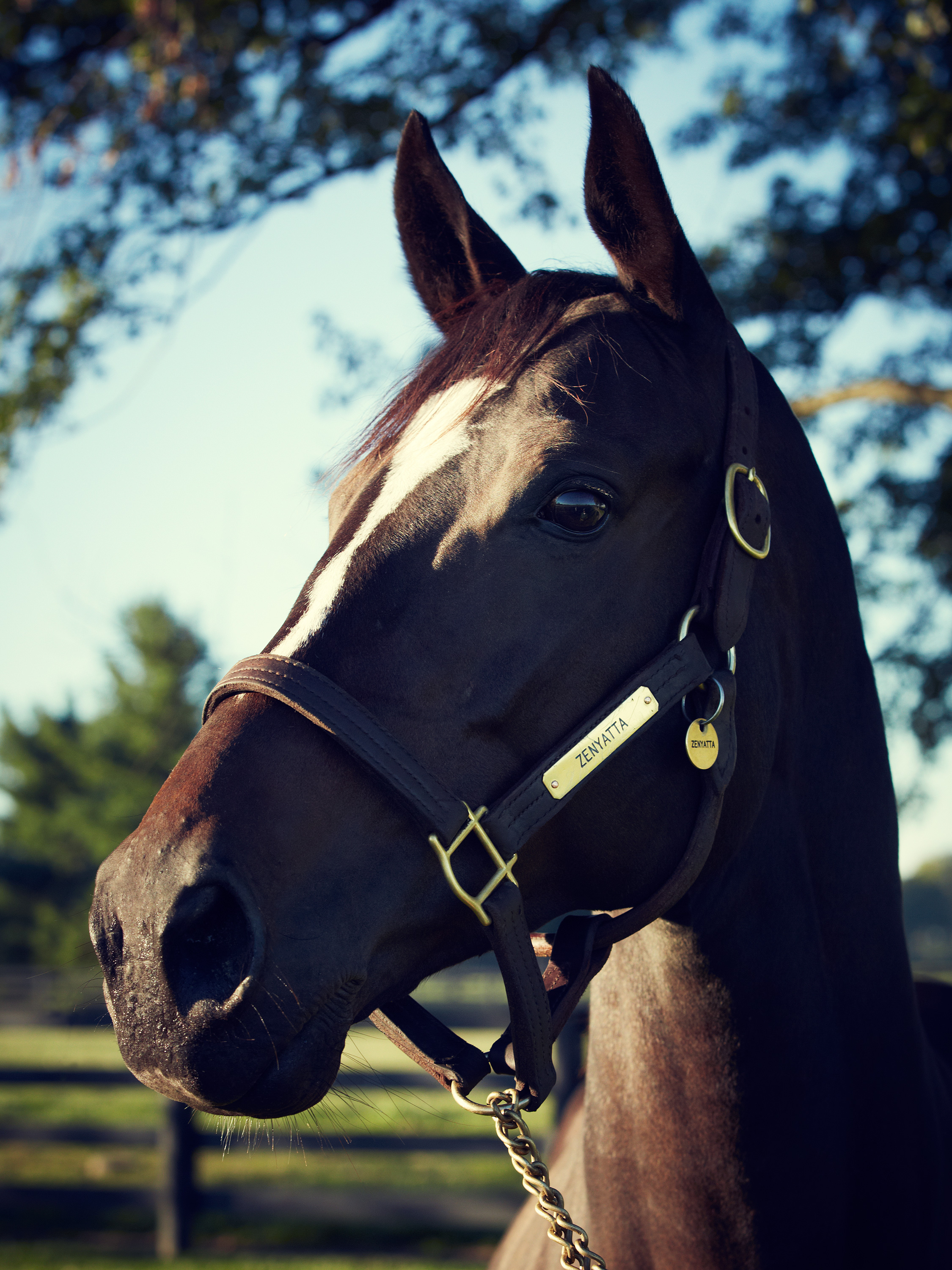
Photo: Joe Pugliese
The famous Zenyatta at Lane's End Farm.
“See his coat,” says Haggin, “the way it sort of shines in little ripples? Classically, that means a horse is really healthy.”
“Now, this is what we call a racehorse,” Bolton says animatedly, rushing to the colt and painting over it in the air with his hands. “The proportions are great, and just everything, legs are sturdy, the line from the withers to the shoulder means he has great reach, the hips are well formed and powerful. I think this will be the session high horse, and I’m going to try to bid on him and hope to get him. However. I think a lot of people are going to be going for this horse. And if you compare him to the other two, well, I mean, good-looking as they are, they’re just kind of Ford Escorts next to this Lamborghini.”
Bolton calls out 132, the last hip number of today’s book. This bay colt, too, is up there in Bolton’s pantheon but is a tad smaller than 131 and seems to Bolton somehow a bit less athletic. “All of them are unformed,” he says and shrugs. “They’re just starting. None of them are really the athletes yet that they can or will be. But I think you’ve now seen what are going to be the big horses today.” He then muses about his competitors, against whom he’ll be jousting after lunch, “You know, what with all this international money streaming in, this sport could get really interesting.”
And with that last dart launched in the bull’s-eye, the George Bolton presale seminar adjourns for lunch, and the auction room.
Kentucky-breds still mean a lot in the world of racing,” Ben Haggin says as we bound down the immaculate two-lane in his SUV to Versailles—pronounced, unapologetically, in full-Kentucky brogue, Ver-sayles. “Lots of people think that that has to do with the central-Kentucky landscape, the kind of rolling hills that are good for the horses, and the limestone in the soil and in the water. It’s not unlike the water for our distilleries that makes the whiskey so special. We think those minerals are good for the horses’ bones.”

Photo: Joe Pugliese
Grooms prepare horses for the day's auction
Keeneland’s story begins with the love for the sporting horse in the people of Kentucky, period. There are horses stuck into corners all over the central part of the state, behind gracious plantation homes and simple farmhouses alike. Pictures of Thoroughbreds are ubiquitous—the Shell station on New Circle Road in Lexington has one in the men’s room, along with a huge horse-head decal on the door. Thoroughbreds are, in Ben Haggin’s words, “a crop” in the noblest Southern sense, one that is supported by and that reaches every level of Kentucky society.
Versailles is the pinnacle of that, the breeding ground, its gentle hills scored by a lattice of impeccably carpentered four-rail fences that run for miles, pastures dotted with equine forms around every bend in the road. Haggin and I are headed out to Lane’s End, the storied 3,000-acre breeding farm owned and run by the Farish family, son Bill—Haggin’s partner in Woodford Racing —and father Ambassador William Stamps (Will) Farish III, a seventy-three-year-old Texas oilman and former U.S. envoy to the Court of St. James. This morning the ambassador will be on hand to show us Zenyatta, the Kentucky-bred filly who won nineteen consecutive stakes races over three years and who retired in 2010 to Lane’s End to breed. We’re also going to see her new colt, just born at Lane’s End three months ago.
Named for the 1980 album by the Police—Zenyattà Mondatta—by her owner, Jerry Moss, who signed the group to A&M Records back in the day, Zenyatta’s an absolute star in Kentucky and at Keeneland, but she’s not the only star at Lane’s End. The stallion barn is thronged with celebrities: A.P. Indy, the Belmont-winning son of Triple Crown winner Seattle Slew, recently retired as a high-earning sire; Smart Strike (who commands an $85,000 stud fee); Candy Ride ($50,000); and Curlin, Smart Strike’s son ($40,000).

Photo: Joe Pugliese
A horse comes out of the barn
The importance of pedigree in feeding the sport with athletes can be understood by studying the staggering schedule of “stands” for a stakes-winning racing stallion who has left racing and entered his breeding career. Let’s take Mineshaft ($35,000 per stand), sired by A.P. Indy, or seen another way, a Seattle Slew grandson, now in the stallion barn at Lane’s End. Mineshaft has, to date, five “crops” of foals. In those five crops—in other words, five years of mating—Mineshaft has to his credit 357 foals of racing age (at $35,000 per), which is to say, foals of two years or older. Those foals have earned $20.5 million at the races to date (and counting). Just a little math will help us develop a picture of this robust sire’s bedroom activities: He’s mounting seventy-plus mares a year.
With bright blue eyes, khakis, and a sweater draped rakishly around his shoulders, the patron of all this, Ambassador Farish, receives us in the well-appointed offices at Lane’s End; immediately we pile into some Range Rovers and strike out for the mares’ barn. The notion is to photograph Zenyatta against what can only be described as the paradisiacal vista of the farm itself, tree lines and fence lines weaving a sort of bucolic symphony over the hills.
“You know, the planning that goes into siting the fences on a horse farm is really complex,” the ambassador says as we walk through the morning dew up the hill behind the noble dark bay filly and her groom. We’re walking in the little alley between two pastures—in addition to the four-rail height of five and a half feet, double fences are a habitual way to delineate territory between horses so that they won’t be tempted to jump. “The other thing that’s important is that you have absolutely no hard corners. Just think about that.”
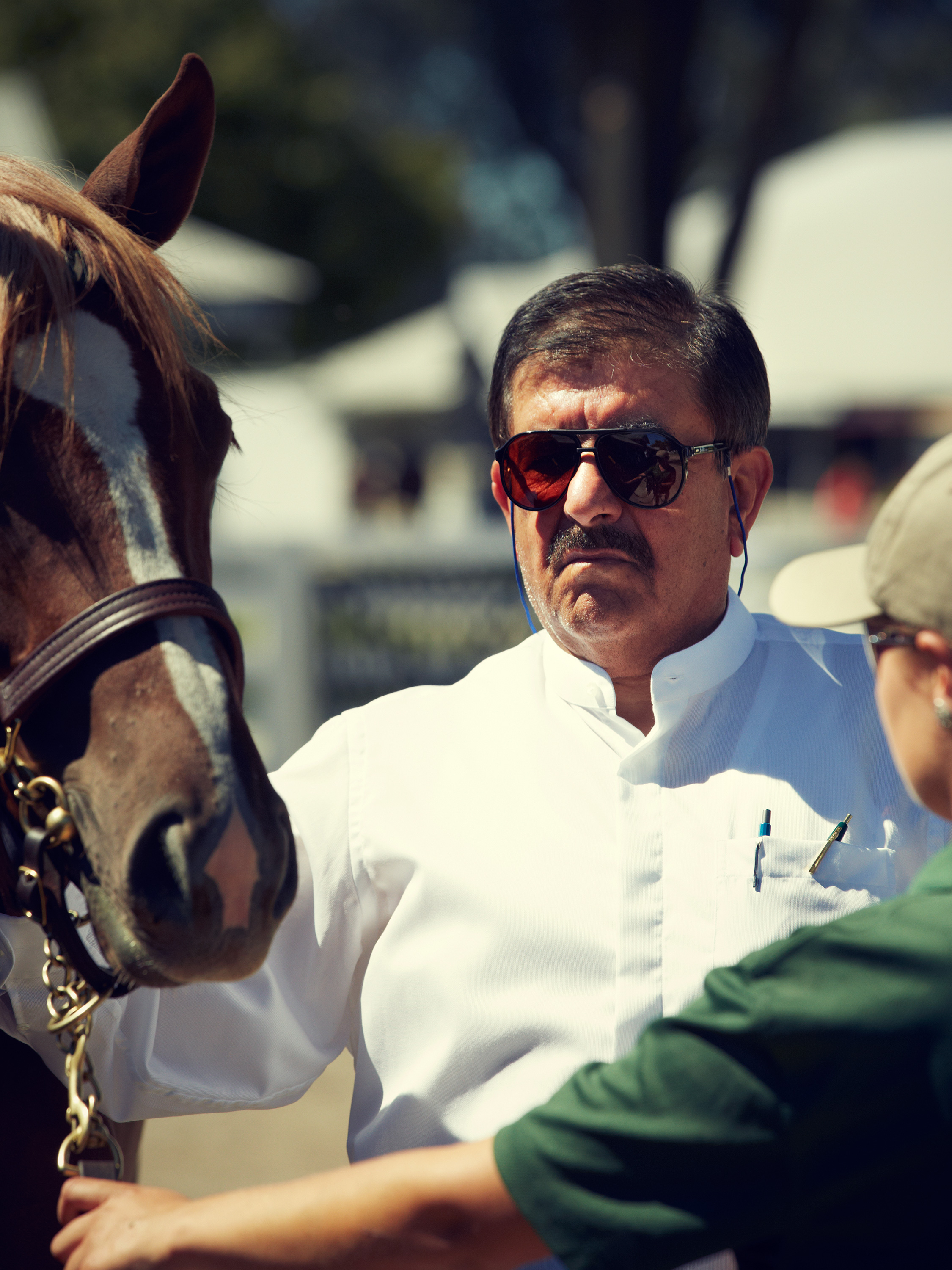
Photo: Joe Pugliese
Sheikh Hamdan inspects a yearling
Now, that is a hard thought. While the gent-ly rounded corners of all the pastures give the fences quite the musical sweep, it’s an immense amount of work on 3,000 acres’ worth of fencing, and it’s hard-ass security-based reasoning that is behind it. Nobody wants a cocky three-million-dollar stallion to rear up and gain support from one side of a hard 90-degree corner while bashing his hooves at the other tangent. He’ll hurt himself, and others. Which is another way of saying, horse farms take elements from resorts and hospitals, with every detail thought through to maximize the comfort and safety of these intensely valuable charges. All of which, in addition to Lane’s End’s bluegrass perfection, is why the famously passionate horsewoman and breeder Queen Elizabeth has bunked—if the queen can be said to “bunk” anywhere—at Lane’s End with the Farishes on five trips to the States.
When we get to the top of the hill, the groom puts Zenyatta through the gate and lets her go. She comes to us, nuzzling through the fence rails. Zenyatta’s in foal now, having gotten pregnant in May. Suddenly the ambassador is climbing the fence and is in the pasture with her, she’s nuzzling his hand, he’s happy as a lark, a horse farmer in his element.
“When she arrived at Keeneland last year before we brought her to the farm, the plane got in late at night, and there was a crowd at the paddock waiting to greet her,” the ambassador says. “She actually went around the ring and greeted people. It was like she was going to give a speech. Anyway, she’s a good girl and she loves crowds.” He pauses. “And,” he adds with a smile, “the crowds love her.”
Back at the mare’s barn, the grooms bring out Zenyatta’s colt, a leggy, dark bay standing there a little undone and askew, like a kid who’s come in from playing with his shirttail out and his hat on backward.
“Can you imagine what that colt would sell for if the Mosses would ever sell it?” says Ben Haggin quietly. “Three million? Four? Sky’s the limit.”

Photo: Joe Pugliese
A young prospect's forearm
Business, in the form of this colt, is off and running.
The results of the 2012 September sales at Keeneland are astounding for the laity, and, for horsemen, very healthy: In the twelve days from September 10 to September 21, 2,516 head were sold, bringing $219,781,500 into the coffers of the breeders and consignors offering colts and fillies at the fair. An average of $18 million per day changed hands in the Keeneland pavilion for the 2,516 unproven, unraced, undeveloped adolescent athletes. Each individual transaction took about three minutes. And the crops keep a-comin’: Keeneland catalogued 3,958 yearlings for its November sale.
This is an extreme, no-bull, high-wire global operation, in the sense that people from around the world—acting on research and their guts, but mostly their guts—compete ferociously against one another at such stakes for the “best” unproven athletes. Any way we look at it, it’s a disposition of big money in a highly concentrated period of time—during which increments of seconds under the gavel can mean a jump of fifty thousand dollars, or more. The intensity and velocity with which the money changes hands are built on the fact that the knowledgeable buyer will have done much research leading up to the sale; will have had bloodstock advisers take a look at the horse or horses, will have examined the Keeneland “repository,” or the digital compilation of veterinary data, including X-rays and bone-density studies, and in some cases will have even dispatched their own veterinarians to examine the prospects.
But none of the preparation means that anybody can predict what will happen.
By mid-afternoon on opening day, the great swarm of people around the barns begins to gird for battle at their preferred stations in and around the sales pavilion. A sense of who’s here to buy can be had in the pavilion’s lobby, where there are five clocks bolted to the wall bearing, left to right, the names of Keeneland’s principal client cities in bold: SYDNEY; TOKYO; LEXINGTON; LONDON; DUBAI.
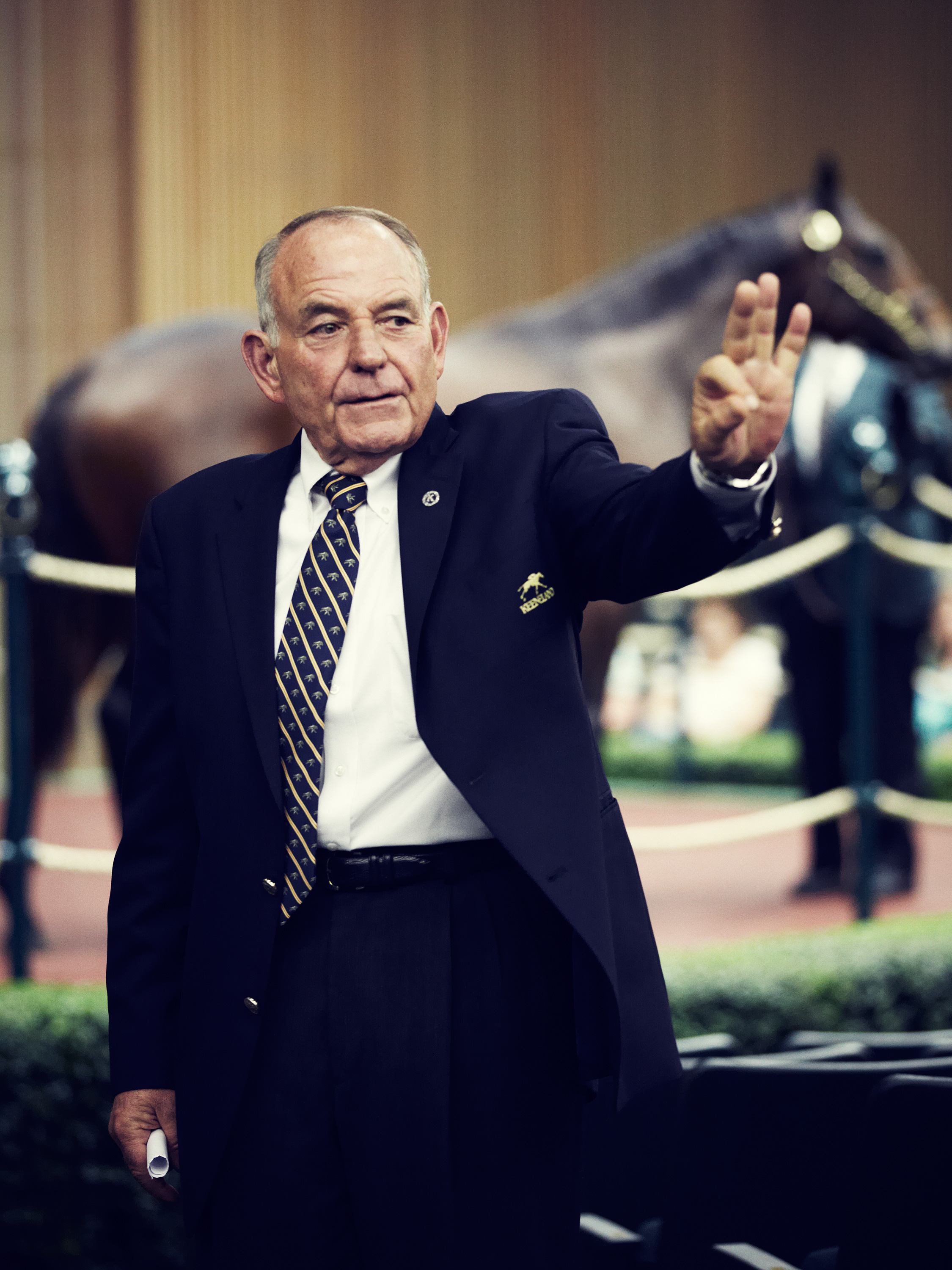
Photo: Joe Pugliese
Bid spotter Pete McCormick
The sales pavilion lies just east of Keeneland’s track. It consists of a theater-in-the-round, at the bottom of which, rather than a stage, is the auctioneer’s stand and immediately below that, the sales ring, a pinched half circle of turf around which the horses are paraded as they are sold. Stretched out behind the auctioneer’s stand—along a hall leading to the outside—is a holding area for the yearlings who are next under the hammer, and a bit farther back, the show ring. The show ring is where the horses are brought and walked when they come from the barns.
Together, the show ring and the holding area compose a sort of gauntlet for the horses, and are completely open to the buyers and their entourages, who line the way as the horses wait to be walked up under the hammer. There’s even a patio bar along the route, which only adds to the friction. Some buyers—notably, the Irish, but others as well—actually prefer to bid from the holding area rather than seat themselves in the auction proper, which is why Keeneland’s auctioneers have stationed two bid spotters whose booths are suspended over the teeming mob out back.
“So, watch your hands,” Ben Haggin says—and he means it—as he and I take our seats on the left side of the theater about five rows behind his father’s assigned seats, Haggin’s father, Louis, being one of the three titans of the Keeneland board.
I know what Haggin is saying but don’t realize the import of each small movement until I see the half dozen bid spotters patrolling the broad aisles as they scan the crowd. The bid spotters are the police, actually, the laserlike eyes of the auctioneers. Each one mans his own regular section of the theater, and many of the spotters have relationships going back years, in some cases, with regular buyers who are assigned seats. A good example would be the bid spotter for our section, on the far left, a grand, leather-faced, all-business Kentuckian named Pete McCormick. McCormick spots the bids from, among others, D. Wayne Lukas, the renowned Hall of Fame trainer who’s won the Derby four times, the Preakness five times, and the Belmont four times. Sitting just across the aisle from Haggin and me, resplendent in a bright yellow shirt, a yellow sweater vest, and aviators, the godlike, immutable Lukas is here to buy for the owners whose horses he trains.
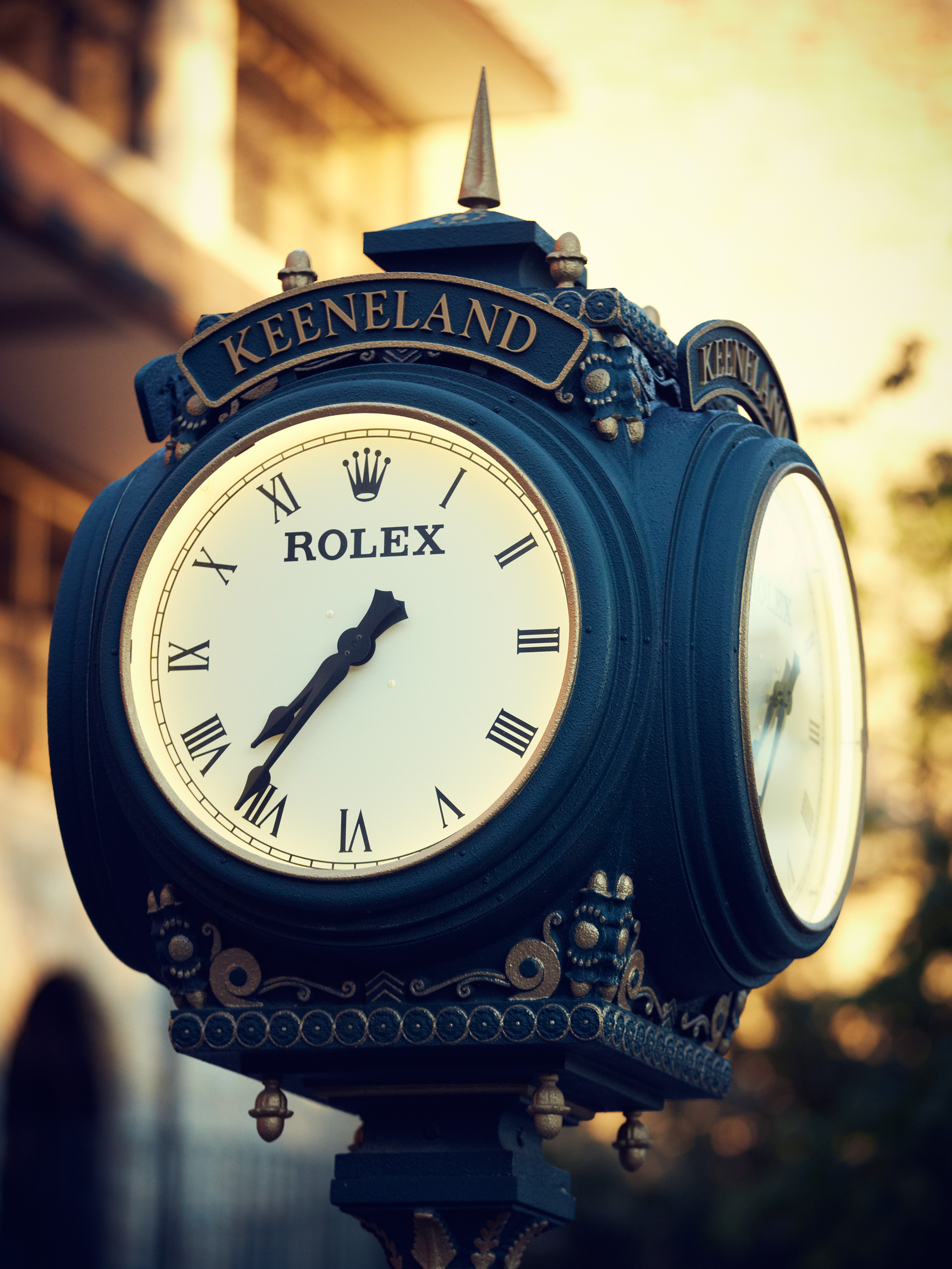
Photo: Joe Pugliese
The clock winds down on another day at Keeneland
“What Lukas will do,” Haggin explains, “is just sit there. You won’t see him move. He will have told Pete something like, ‘Until I move my pen from my right hand to my left, I’m in.’ Otherwise, he won’t move a muscle.”
Lukas does seem as if he’s been carved into Mount Rushmore. Most bidders in the theater or out back by the holding pen will have made some kind of arrangement with their spotters, and of course, everybody’s trying to signal the spotters while trying to hide their intentions from the crowd. Some buyers, such as Sheikh Hamdan of Abu Dhabi, don’t bother coming into any of the physical auction spaces, preferring to send agents. As a celebrated Hall of Famer, Lukas knows that people will be studying him, but he comes anyway—only to make these infinitesimally small movements to cut his involvement in a bid. It’s an awesome strategy for buying horses: He doesn’t bid; he just lets the money flow, till he says no.
The auctioneer begins his machine-gun drone on the first horse, an Irish-bred chestnut colt that goes for $250,000 in about ninety seconds. Then a second colt sells for $200,000, and then it’s up to $325,000, takes a quick dip down to a “cheap” colt at $130,000, and zooms up to $500,000. In the first twelve minutes, the first seven horses bring $2,010,000. The room has some bounce.
Auction room denizens can know quickly who’s bought what, from the sales documents delivered to the buyers in the room, from the sales room out in the pavilion itself, or, after a fifteen-minute lag as paperwork is finalized, from the Keeneland website. Sheikh Hamdan is, according to his habit, not in the room, but is busily sewing up the more expensive stock from this first day’s book, meaning the colts whose prices seem to be at a half million or more. Inevitably, these colts have amazing sires and dams—he buys two of them in short order. A Japanese syndicate, in the middle of the room, hits hip number 35 for $475,000, and then, six horses later: ka-boom, stable owners Charles and Maribeth Sandford hit the day’s first million-dollar colt, hip number 41, a lithe-looking bay that, one suspects, Sheikh Hamdan was also driving for.
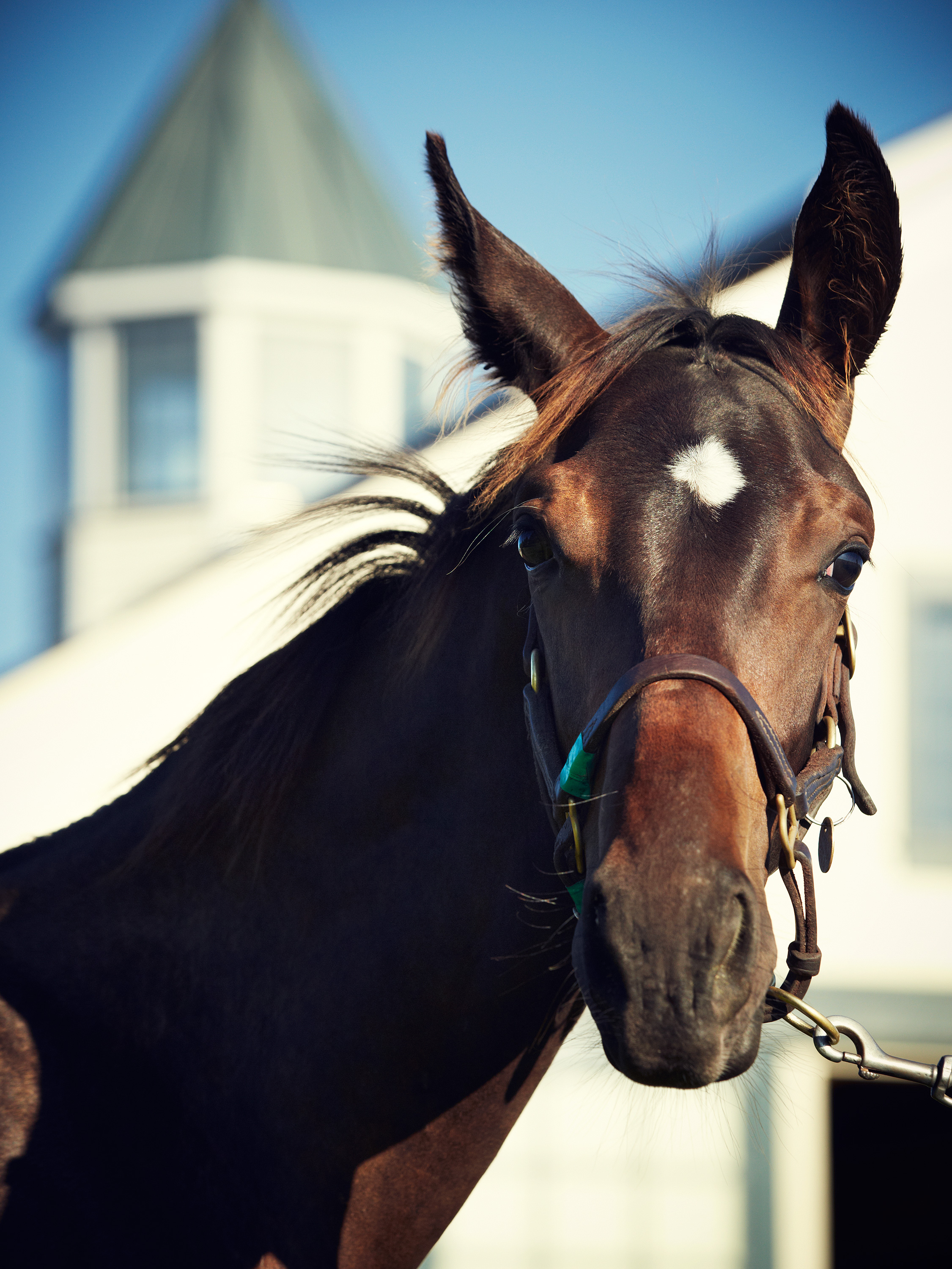
Photo: Joe Pugliese
Zenyatta's colt at Lane's End
Seven minutes later, an agent for a Kentucky consortium hits hip number 45, a colt whose sire was Smart Strike, for $1.3 million. Sheikh Hamdan then swoops in and grabs a colt for $625,000, and, looking at the results, one can almost sense that he’s waiting back on his 747, in a hovering falconlike way, for something bigger. He pounces smartly on hip number 72, the first colt that George Bolton pulled out of the barn for Haggin and me before lunch. Hamdan puts $675,000 on the barrelhead for the horse, bringing his session expenditures to $1,300,000, approximately halfway through this day’s book.
The writing is on the wall; Sheikh Hamdan will not be stopped. In the second half of the book, there are a dozen or more half- million-dollar colts that he studiously avoids, and one begins again to have that sense of the falcon hovering. The question is, if he’s avoiding the $500,000-to-$750,000 bracket now, what’s he waiting for?
It doesn’t take long for George Bolton’s other two predictions to roll around, hip numbers 131—the colt Bolton was most excited about—and hip number 132, the last horse in today’s session. Bolton was in the bidding but never had a chance: The busy sheikh moves in like Bigfoot and picks them both up—$1.65 million for hip number 131, the session high horse, and $850,000 for hip number 132.
Bolton, who had sat with some of his partners during the session, bounces up to me in the hall outside the pavilion. I thank him for his uncanny precision.
“Too much for me,” he says, laughing, as a football player might who knew he’d just been plowed over, “but at least I steered you right.”
For a while after the session, as I watch the van companies busily pulling up to the barns to take the day’s $45.6 million in livestock to new homes all over the world, one thing grows clear: In addition to the obvious things such as money, there are a couple of finer, tougher elements in the tool kit of a true horseman. Of these, arguably the main ones are a Job-like patience and the sportsman’s ability to take a hit and get back in the game.
Which is precisely what it takes to run at Keeneland.







